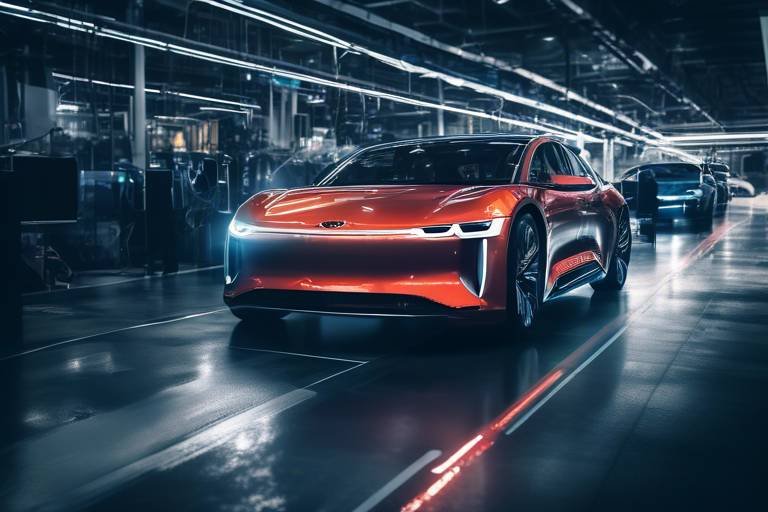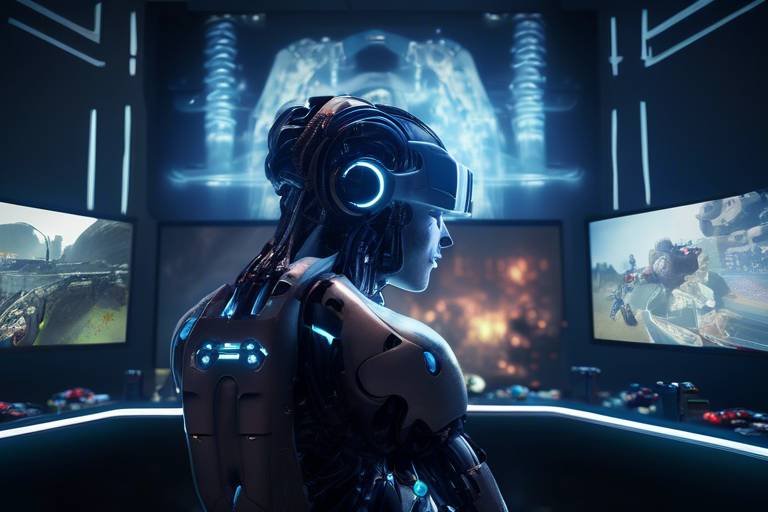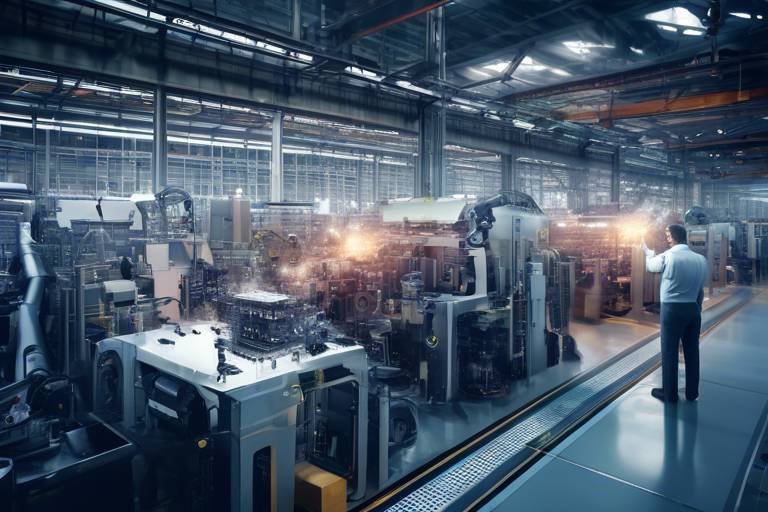How AI is Changing the Automotive Industry
Artificial Intelligence (AI) is not just a buzzword anymore; it's a game-changer in the automotive industry. Imagine a world where your car not only drives itself but also learns your preferences, predicts maintenance needs, and enhances safety like never before. Sounds futuristic, right? Well, that future is already unfolding before our eyes. From manufacturing processes that are more efficient than ever to vehicles that can navigate complex environments autonomously, AI is reshaping the automotive landscape in profound ways. In this article, we will delve into the transformative impact of AI on the automotive sector, exploring advancements in manufacturing, safety, customer experience, and the exciting trends that lie ahead.
Let’s kick things off by examining how AI is revolutionizing vehicle manufacturing. Traditional manufacturing methods often involve tedious manual labor, but with AI, we're ushering in an era of automation and predictive analytics. Picture a factory where robots work tirelessly, assembling vehicles with pinpoint accuracy and efficiency. This not only enhances productivity but also significantly reduces costs. AI systems can analyze data in real-time, predicting equipment failures before they happen. This predictive maintenance leads to fewer downtimes and ensures that the production line runs smoothly. The result? Higher quality vehicles and happier customers.
Now, let’s shift gears and talk about autonomous vehicles. The development of self-driving cars is heavily reliant on AI technologies. These vehicles are designed to navigate and make decisions without human intervention, which is nothing short of revolutionary. Imagine sitting back and relaxing while your car takes you to your destination. But how does this work? It all boils down to sophisticated algorithms and advanced sensor technologies that allow the vehicle to perceive its environment and respond accordingly.
At the heart of autonomous driving is sensor technology. This technology processes data from various sensors—like cameras, ultrasonic sensors, and GPS—to interpret the vehicle's surroundings. Think of it as the car's eyes and ears, constantly gathering information to ensure safe navigation. The synergy between AI and sensor technology is what enables vehicles to react to road conditions, obstacles, and even pedestrians, making it a crucial component of self-driving systems.
Among the various sensors, LiDAR and radar systems stand out as essential tools for detecting obstacles and understanding the vehicle's environment. LiDAR uses laser beams to create a detailed 3D map of the surroundings, while radar systems utilize radio waves to detect objects. Together, they provide a comprehensive view of the environment, enhancing safety and reliability in autonomous driving. Imagine your car being able to "see" in all directions, even in poor weather conditions. That's the power of LiDAR and radar.
Another critical aspect of autonomous vehicles is computer vision. This technology allows vehicles to recognize and interpret visual information from their surroundings. It’s like giving your car a brain that can understand what it sees. From identifying traffic signs to recognizing lane markings, AI-driven computer vision systems are vital for the effectiveness of autonomous navigation. When combined with machine learning, these systems continuously improve, learning from each journey to enhance performance.
Safety is paramount in the automotive industry, and AI is significantly improving safety features in modern vehicles. With the integration of AI, we are witnessing a decrease in accidents and fatalities on the roads. Various AI-driven safety technologies, such as automatic emergency braking and collision avoidance systems, are making driving safer. Imagine a car that can predict a potential collision and take action before you even realize there's a danger. That's the power of AI-enhanced safety features.
AI is also transforming infotainment systems in vehicles, making them more intuitive and personalized. Gone are the days of clunky interfaces and complicated controls. Now, AI is enhancing user experience and connectivity within cars. Imagine being able to control your car's functions with just your voice or having a system that understands your preferences and adapts accordingly.
Voice recognition technology powered by AI allows drivers to control various functions hands-free. This advancement not only adds convenience but also enhances safety by allowing drivers to keep their eyes on the road. Think about it: instead of fumbling with buttons or touchscreens, you can simply say, “Play my favorite playlist,” and your car responds. This seamless interaction is a game-changer for modern drivers.
Furthermore, AI algorithms analyze user preferences to provide personalized content and recommendations in infotainment systems. Whether it's suggesting the best route based on traffic or recommending music that fits your mood, this personalization enhances the overall driving experience. It’s like having a co-pilot who knows you inside out!
The future of AI in the automotive industry promises exciting innovations, from fully autonomous vehicles to smarter manufacturing processes. As we look ahead, we can expect to see advancements that will not only redefine how we drive but also how vehicles are built. However, with these advancements come challenges, including regulatory hurdles and ethical considerations that need to be addressed. The road ahead is filled with potential, and it’s up to us to navigate it wisely.
- What is the role of AI in autonomous vehicles? AI enables cars to navigate and make decisions without human intervention by processing data from various sensors.
- How does AI improve vehicle manufacturing? AI enhances efficiency and precision through automation and predictive analytics, leading to reduced costs and improved quality.
- What are some AI-driven safety features? Examples include automatic emergency braking, lane-keeping assist, and collision avoidance systems.
- Will AI replace human drivers? While AI is advancing rapidly, full autonomy will require careful consideration of safety and regulatory issues.

AI in Vehicle Manufacturing
Artificial intelligence is truly revolutionizing the way vehicles are manufactured, ushering in a new era of efficiency and precision. Imagine a factory floor where machines communicate seamlessly, adjusting their operations in real-time to optimize production. That's the power of AI! By integrating advanced algorithms and machine learning, manufacturers can now predict equipment failures before they happen, significantly reducing downtime and maintenance costs. This predictive analytics capability not only enhances productivity but also ensures that the quality of the vehicles produced meets the highest standards.
One of the most remarkable aspects of AI in vehicle manufacturing is its ability to streamline the entire production process. For instance, with the help of AI, manufacturers can analyze vast amounts of data from various stages of production. This analysis can identify bottlenecks and inefficiencies, allowing companies to implement solutions that improve workflow. As a result, the entire manufacturing cycle becomes faster and more cost-effective, which is crucial in today's competitive market.
Moreover, AI-driven automation is taking over repetitive tasks that were once performed by human workers. This shift not only increases productivity but also enhances safety on the factory floor. Robots equipped with AI can perform tasks with remarkable precision, reducing the risk of human error. This leads to fewer accidents and injuries, creating a safer working environment. In addition, the use of robotics allows human workers to focus on more complex and creative tasks, which can lead to innovation and improvements in vehicle design.
To give you a clearer picture, let’s look at some key benefits of AI in vehicle manufacturing:
- Cost Reduction: AI helps reduce operational costs through improved efficiency and predictive maintenance.
- Quality Improvement: Enhanced data analysis ensures that vehicles meet strict quality standards.
- Increased Safety: Automation minimizes human error and creates a safer workplace.
- Faster Production: Streamlined processes lead to quicker turnaround times for vehicle production.
However, it's not all smooth sailing. The integration of AI technologies comes with its own set of challenges. Manufacturers must invest in training their workforce to work alongside advanced AI systems. Additionally, there is a constant need for updates and maintenance of these technologies to keep up with the rapid pace of innovation. As we look to the future, the automotive industry will need to balance the benefits of AI with the challenges it brings.
In conclusion, the impact of AI on vehicle manufacturing is profound and multifaceted. By enhancing efficiency, precision, and safety, AI is not just changing how cars are made; it's reshaping the entire industry. As we move forward, we can expect even more exciting advancements that will continue to push the boundaries of what’s possible in automotive manufacturing.

Autonomous Vehicles
The development of is one of the most exciting advancements in the automotive industry, and it heavily relies on cutting-edge AI technologies. Imagine a car that can drive itself, making decisions in real-time without human intervention. Sounds like something out of a science fiction movie, right? Well, it’s becoming a reality! Autonomous vehicles are equipped with sophisticated systems that allow them to interpret their environment, navigate safely, and even communicate with other vehicles. This is not just a trend; it's a revolution that promises to reshape our roads and our lives.
Currently, several companies are testing self-driving cars on public roads, and while we’re not at the point of completely autonomous vehicles everywhere, the progress is undeniable. These vehicles utilize a combination of machine learning, computer vision, and advanced sensors to perceive their surroundings. The potential benefits are immense, ranging from reduced traffic congestion to lower accident rates. But what exactly makes these vehicles tick? Let’s delve into the technology that powers them.
At the heart of autonomous vehicles are various technologies that work in harmony to ensure safe navigation. For example, consider the role of sensor technology. These sensors gather data about the vehicle’s environment, including the presence of other cars, pedestrians, and obstacles. This information is then processed by AI algorithms that make split-second decisions, allowing the vehicle to react appropriately. The integration of different sensor types, such as LiDAR and radar systems, enhances the vehicle's understanding of its surroundings, making it more reliable in various driving conditions.
Sensor technology is not just a fancy add-on; it’s a critical component of autonomous driving. These sensors can detect a wide range of environmental factors, including distance, speed, and even the texture of the road. For instance, LiDAR uses laser pulses to create a detailed 3D map of the vehicle's surroundings, while radar systems can detect objects at greater distances and in challenging weather conditions. Together, they provide a comprehensive view that allows the vehicle to navigate safely.
LiDAR and radar systems are essential for the functionality of autonomous vehicles. By emitting signals and measuring the time it takes for them to bounce back, these systems can accurately gauge distances and identify obstacles. This capability is crucial for avoiding collisions and ensuring smooth navigation. Additionally, these technologies work in tandem with AI to enhance the vehicle's decision-making process. For example, if a LiDAR sensor detects an object in the vehicle's path, the AI can quickly analyze the situation and decide whether to slow down, stop, or maneuver around it.
Another key player in the realm of autonomous vehicles is computer vision. This technology enables vehicles to recognize and interpret visual information from their surroundings, such as traffic signs, lane markings, and pedestrians. By utilizing cameras and sophisticated algorithms, autonomous vehicles can "see" the world much like humans do. This capability is vital for ensuring safe navigation and compliance with traffic regulations. Imagine driving down a busy street; the car needs to constantly assess its environment to make safe decisions. That's where computer vision shines, allowing for real-time analysis and response.
The future of autonomous vehicles is bright, but it’s not without its challenges. As we push the boundaries of what’s possible, issues like regulatory hurdles, ethical considerations, and public acceptance must be addressed. Nevertheless, the potential for a safer, more efficient transportation system is within reach, and AI is leading the charge.
- What are autonomous vehicles? Autonomous vehicles are cars that can drive themselves without human intervention, utilizing AI and various sensors to navigate.
- How do autonomous vehicles work? They work by using a combination of sensors, cameras, and AI algorithms to interpret their environment and make driving decisions.
- Are autonomous vehicles safe? While they have the potential to reduce accidents, safety depends on the technology's reliability and the regulatory framework in place.
- When will we see fully autonomous vehicles on the road? It's difficult to predict, but many experts believe that fully autonomous vehicles could be common within the next decade, pending technological and regulatory advancements.

Sensor Technology
When we talk about autonomous vehicles, one of the unsung heroes in this technological revolution is undoubtedly . Imagine a car that can "see" and "understand" its surroundings just like a human driver would. This capability is not just a futuristic dream; it's a reality made possible by a combination of advanced sensors and artificial intelligence (AI). These sensors gather critical data from the environment, which AI then processes to make real-time decisions, ensuring a safe and efficient driving experience.
At the heart of this technology are several types of sensors, each playing a unique role in the vehicle's ability to navigate autonomously. The most prominent among them include:
- LiDAR (Light Detection and Ranging): This technology uses laser beams to create a detailed 3D map of the vehicle's surroundings. It's like having a high-definition view of everything around you, allowing the car to detect obstacles with incredible precision.
- Radar: Radar systems are essential for detecting objects at longer distances, even in adverse weather conditions. They emit radio waves that bounce off objects, helping the vehicle to identify potential hazards.
- Cameras: Visual data captured by cameras helps the vehicle recognize traffic signs, lane markings, and pedestrians. This is akin to how our eyes work, providing crucial visual context for the AI.
These sensors work in tandem, feeding data into the AI system, which interprets the information to make split-second decisions. For instance, if a pedestrian suddenly steps into the road, the AI must quickly analyze data from the LiDAR, radar, and cameras to determine the best course of action—whether to brake, swerve, or accelerate.
The integration of sensor technology and AI is not just about making cars smarter; it's also about enhancing road safety. By continuously monitoring the environment and reacting faster than a human driver could, these systems significantly reduce the chances of accidents. In fact, studies suggest that vehicles equipped with advanced sensor technology can lower the risk of collisions by as much as 40%.
However, it's important to note that while the technology is impressive, it’s not infallible. Factors like poor weather conditions, sensor malfunctions, or unexpected road scenarios can still pose challenges. Therefore, ongoing advancements in sensor technology and AI algorithms are crucial for overcoming these hurdles and making autonomous driving a safe and reliable option for everyone.
In summary, sensor technology is a cornerstone of the autonomous vehicle ecosystem, enabling cars to perceive their environment and make informed decisions. As we continue to innovate and improve these systems, the dream of fully autonomous vehicles becomes increasingly attainable, paving the way for a future where driving is not just a task but a seamless, safe, and enjoyable experience.

LiDAR and Radar Systems
When we talk about autonomous vehicles, one of the most exciting technologies that come to mind is LiDAR (Light Detection and Ranging) and radar systems. These technologies are the eyes and ears of self-driving cars, allowing them to understand and interpret their surroundings in real-time. Imagine driving through a bustling city or a quiet country road; the ability of a vehicle to perceive everything around it is crucial for safe navigation. LiDAR uses laser light to create a detailed 3D map of the environment, while radar systems utilize radio waves to detect objects and their speed. Together, they form a powerful duo that enhances the safety and reliability of autonomous driving.
LiDAR works by emitting thousands of laser pulses per second and measuring the time it takes for each pulse to bounce back after hitting an object. This allows the vehicle to create a precise 3D model of its surroundings, identifying everything from pedestrians to road signs. On the other hand, radar systems excel in detecting objects at longer distances and in various weather conditions, such as fog or rain, where LiDAR might struggle. The combination of these two technologies provides a comprehensive view that is essential for making informed driving decisions.
Here's a quick look at how LiDAR and radar systems complement each other:
| Technology | Strengths | Weaknesses |
|---|---|---|
| LiDAR | High-resolution 3D mapping, precise distance measurements | Limited range in adverse weather conditions |
| Radar | Long-range detection, reliable in various weather | Lower resolution compared to LiDAR |
Moreover, the integration of these systems with AI algorithms allows for real-time data processing, enabling the vehicle to make split-second decisions. For example, if a pedestrian suddenly steps onto the road, the AI can quickly analyze the data from both LiDAR and radar to determine the best course of action—whether to brake, swerve, or accelerate. This level of responsiveness is what makes autonomous driving not just a dream but a reality.
However, the journey to fully autonomous vehicles isn't without challenges. As these technologies continue to evolve, manufacturers must address issues like cost, scalability, and regulatory hurdles. But with the rapid advancements in AI and sensor technology, the future looks promising. The combination of LiDAR and radar systems will undoubtedly play a pivotal role in shaping the next generation of vehicles, making our roads safer and more efficient.
- What is LiDAR? LiDAR stands for Light Detection and Ranging, a technology that uses laser light to measure distances and create 3D maps of the environment.
- How does radar work in autonomous vehicles? Radar uses radio waves to detect objects and measure their speed, making it effective in various weather conditions.
- Why are LiDAR and radar systems important for self-driving cars? These systems provide critical data that helps autonomous vehicles navigate safely and make informed driving decisions.
- What are the challenges of using LiDAR and radar? Challenges include high costs, limited range in certain conditions, and the need for regulatory approval for widespread use.

Computer Vision
Imagine a world where your car can see and understand its surroundings just like you do. This is the magic of , a technology that allows vehicles to interpret visual information from the environment. By leveraging advanced algorithms and machine learning, computer vision systems enable cars to identify objects, recognize road signs, and even detect pedestrians. This capability is not just impressive—it's essential for the safe operation of autonomous vehicles.
At the heart of computer vision is the ability to process images and videos in real-time. Cameras installed in vehicles capture high-resolution images, which are then analyzed by AI algorithms. These algorithms break down the visual data into understandable components, allowing the vehicle to make informed decisions. For example, when a car approaches a stop sign, the computer vision system recognizes the sign and communicates this information to the vehicle's control system, prompting it to stop.
One of the key advantages of computer vision is its ability to operate under various conditions. Whether it's bright sunlight or heavy rain, the system continuously adapts to ensure accurate interpretation of the environment. However, the effectiveness of computer vision also relies on the quality and quantity of data it receives. The more diverse the training data, the better the system becomes at recognizing different scenarios. This is why many manufacturers are investing heavily in collecting vast amounts of visual data from real-world driving experiences.
The integration of computer vision into autonomous vehicles introduces several benefits:
- Enhanced Safety: By accurately detecting obstacles and understanding road conditions, computer vision significantly reduces the risk of accidents.
- Improved Navigation: The technology allows for better route planning and decision-making, making driving smoother and more efficient.
- Real-Time Feedback: Vehicles can respond instantly to changes in their surroundings, ensuring a safer driving experience.
In conclusion, computer vision is a cornerstone of the future of autonomous driving. As this technology continues to evolve, we can expect to see even more sophisticated systems that not only enhance safety but also make driving a more enjoyable experience. The potential for innovation is immense, and as we embrace these advancements, the roads of tomorrow will be safer and smarter.
- What is computer vision? Computer vision is a field of artificial intelligence that enables computers and systems to interpret and understand visual information from the world.
- How does computer vision work in vehicles? Vehicles equipped with cameras capture images, which are then processed by AI algorithms to identify objects, road signs, and other critical information for safe navigation.
- What are the benefits of computer vision in autonomous vehicles? Benefits include enhanced safety, improved navigation, and real-time feedback, all of which contribute to a safer driving experience.

AI-Enhanced Safety Features
In today's fast-paced world, road safety has become a paramount concern for both manufacturers and consumers. With the integration of artificial intelligence into vehicle safety systems, the automotive industry is witnessing a significant transformation. AI-enhanced safety features are not just futuristic concepts; they are becoming a reality that is saving lives and preventing accidents. Imagine a car that can predict potential hazards before they occur, almost like having a sixth sense. This is the power of AI in enhancing vehicle safety.
One of the most notable advancements in AI-driven safety technology is the development of Advanced Driver-Assistance Systems (ADAS). These systems utilize a combination of sensors, cameras, and AI algorithms to monitor the vehicle's surroundings and provide real-time feedback to the driver. Some of the key features included in ADAS are:
- Automatic Emergency Braking: This feature detects an impending collision and automatically applies the brakes to prevent or mitigate the impact.
- Lane Departure Warning: AI monitors lane markings and alerts the driver if the vehicle unintentionally drifts out of its lane.
- Adaptive Cruise Control: This system adjusts the vehicle's speed based on the traffic conditions, maintaining a safe distance from the car in front.
These features not only enhance safety but also provide drivers with a sense of confidence while on the road. The data collected from various sensors is analyzed using sophisticated algorithms to make split-second decisions that can mean the difference between a safe journey and a serious accident. In fact, studies have shown that vehicles equipped with these AI-powered safety features have significantly lower accident rates compared to those without.
Furthermore, the integration of machine learning into these safety systems allows them to continuously improve over time. As more data is collected from different driving scenarios, the AI systems learn to identify patterns and predict potential risks more accurately. This adaptive learning process is akin to how humans gain experience, making AI a crucial ally in road safety.
However, while AI-enhanced safety features are groundbreaking, they are not without challenges. Issues such as data privacy, cybersecurity, and the need for regulatory standards are critical topics that need to be addressed as the technology evolves. Manufacturers must ensure that the data collected is securely stored and used solely for enhancing safety, thereby maintaining consumer trust.
In conclusion, AI-enhanced safety features are revolutionizing the automotive industry by providing advanced tools that significantly reduce the risk of accidents. As technology continues to advance, we can expect even more sophisticated systems that will not only protect drivers but also contribute to safer roads for everyone. The journey towards fully autonomous and safe vehicles is underway, and AI is at the forefront of this exciting evolution.
1. What are AI-enhanced safety features?
AI-enhanced safety features are advanced technologies integrated into vehicles that utilize artificial intelligence to improve safety on the road. These include systems like automatic emergency braking, lane departure warnings, and adaptive cruise control.
2. How do these features help prevent accidents?
These features help prevent accidents by using sensors and cameras to monitor the vehicle's surroundings, providing real-time feedback to the driver, and making automatic adjustments to avoid potential collisions.
3. Are AI safety features reliable?
Yes, AI safety features have been shown to significantly reduce accident rates. They continuously learn from driving data, improving their accuracy and effectiveness over time.
4. What challenges do AI safety features face?
Challenges include data privacy concerns, cybersecurity threats, and the need for regulatory standards to ensure the safe use of AI technologies in vehicles.

Smart Infotainment Systems
In today's fast-paced world, are becoming the heartbeat of our vehicles. Imagine stepping into your car, and it instantly knows your favorite playlist, the best route to avoid traffic, and even your preferred temperature setting. This is not just a dream; it's the reality brought to life by artificial intelligence. These systems are transforming the way we interact with our cars, making driving not just a necessity but an experience.
At the core of these intelligent systems is a seamless integration of technology that enhances user experience and connectivity. AI algorithms analyze vast amounts of data—from your driving habits to your entertainment preferences—to create a more personalized driving environment. For instance, when you start your car, the infotainment system might automatically suggest a podcast based on your previous listens or recommend a coffee shop along your route. This level of personalization is not just a luxury; it's becoming an expected norm.
Moreover, voice recognition technology has taken center stage in smart infotainment systems. Gone are the days of fumbling with buttons or taking your eyes off the road. With AI-powered voice interfaces, drivers can control navigation, music, and even their phone calls with simple voice commands. This hands-free capability not only enhances convenience but also significantly boosts safety, allowing drivers to stay focused on the road ahead. Imagine asking your car, “Play my road trip playlist,” and it instantly responds—how cool is that?
To illustrate the impact of AI in smart infotainment systems, consider the following table that highlights key features:
| Feature | Description | Benefits |
|---|---|---|
| Voice Recognition | Hands-free control of car functions | Increased safety and convenience |
| Personalized Recommendations | Suggestions based on user preferences | Enhanced driving experience |
| Real-Time Traffic Updates | Dynamic navigation adjustments | Time-saving and efficient travel |
| Smartphone Integration | Seamless connectivity with mobile devices | Access to apps and features on-the-go |
As we look to the future, the evolution of smart infotainment systems is poised to continue at a rapid pace. With advancements in AI, we can expect even more intuitive interfaces that learn and adapt to our needs. Imagine a system that not only understands your voice but also your mood, adjusting the music and lighting accordingly. The possibilities are endless!
However, with great power comes great responsibility. As these systems become more integrated into our daily lives, concerns about privacy and data security are rising. How do we ensure that our personal information remains safe while enjoying the benefits of such advanced technology? This is a question that both manufacturers and consumers must address as we move forward.
In conclusion, smart infotainment systems are not just a trend; they are a fundamental shift in how we experience driving. By leveraging AI, these systems are making our journeys more enjoyable, safer, and personalized. As we embrace this exciting technology, it's essential to remain informed and vigilant about the implications it brings.
- What is a smart infotainment system?
A smart infotainment system is an integrated technology platform in vehicles that combines entertainment, navigation, and connectivity features, often enhanced by AI. - How does voice recognition improve safety?
Voice recognition allows drivers to control various functions hands-free, reducing distractions and keeping their attention on the road. - Can smart infotainment systems learn my preferences?
Yes, AI algorithms can analyze your habits and preferences to provide personalized recommendations for music, routes, and more. - What are the privacy concerns with smart infotainment systems?
As these systems collect and process personal data, there are concerns about data security and how that information is used or shared.

Voice Recognition
Voice recognition technology is rapidly reshaping the way drivers interact with their vehicles, providing a seamless and intuitive experience that enhances both convenience and safety. Imagine cruising down the highway, hands on the wheel, and simply speaking to your car to change the music or navigate to your next destination. This is not science fiction—it's the reality of modern automotive technology!
At the heart of this transformation lies artificial intelligence, which enables vehicles to understand and process human speech in real time. With advancements in natural language processing (NLP), AI systems are becoming increasingly adept at recognizing different accents, dialects, and even the emotional tone of a voice. This means that your car can not only hear you but also understand you better than ever before.
One of the most significant benefits of voice recognition in vehicles is the ability to keep drivers focused on the road. By allowing hands-free control of various functionalities, such as:
- Making phone calls
- Adjusting climate settings
- Controlling navigation systems
- Playing music or podcasts
...drivers can minimize distractions and enhance their overall safety. In fact, studies have shown that using voice commands can significantly reduce the likelihood of accidents caused by distracted driving.
Moreover, as these voice recognition systems become more sophisticated, they are increasingly capable of providing personalized interactions. For instance, your car can learn your preferences over time and make suggestions tailored specifically to you. Want to listen to your favorite playlist when you start the engine? Your vehicle can do that! This level of personalization not only improves user experience but also fosters a deeper connection between the driver and the vehicle.
However, like any technology, voice recognition is not without its challenges. Issues such as background noise, varying voice tones, and even the presence of multiple passengers can affect the accuracy of voice commands. Manufacturers are actively working on improving these systems to ensure they can function effectively in diverse environments. The future looks promising, and as AI continues to evolve, we can expect even more enhancements in voice recognition technology.
In conclusion, the integration of voice recognition in vehicles is a game changer, transforming the driving experience into something more interactive and engaging. As we look ahead, it's clear that this technology will play a pivotal role in making our roads safer and our journeys more enjoyable.
- How does voice recognition work in cars?
Voice recognition in cars uses advanced algorithms and artificial intelligence to process and understand spoken commands. The system captures audio input through microphones, analyzes the speech patterns, and executes the requested actions. - Can voice recognition systems understand different accents?
Yes! Modern voice recognition systems are designed to recognize various accents and dialects, making them more accessible to a diverse range of users. - Is using voice commands safer than using traditional controls?
Absolutely! Voice commands allow drivers to keep their hands on the wheel and eyes on the road, significantly reducing the risk of distractions that can lead to accidents.

Personalized Recommendations
In today’s fast-paced world, personalization is the name of the game, and the automotive industry is no exception. Imagine getting into your car, and it instantly knows your favorite playlist, suggests the quickest route to your favorite coffee shop, or even reminds you of your upcoming appointments. This is not just a dream; it’s becoming a reality thanks to artificial intelligence (AI). AI algorithms are designed to analyze user behavior and preferences, creating a tailored experience for each driver.
At the heart of this transformation is the ability of AI to process vast amounts of data. By learning from your driving habits, the system can make personalized recommendations that enhance your driving experience. For instance, if you usually prefer a certain radio station during your morning commute, the infotainment system will automatically tune in to that station as soon as you start the car. This kind of intuitive interaction not only makes driving more enjoyable but also saves time and effort.
Furthermore, AI can adapt to your preferences over time. The more you use the system, the smarter it gets. It can suggest alternative routes based on traffic patterns, recommend nearby restaurants based on your dining history, or even alert you to upcoming events that match your interests. This level of personalization creates a seamless connection between the driver and the vehicle, making every journey feel unique and catered to individual needs.
Here’s a closer look at how personalized recommendations work in modern vehicles:
| Feature | Description |
|---|---|
| Music Preferences | AI analyzes your listening habits to suggest playlists or tracks that match your mood. |
| Navigation | Suggests routes based on previous trips, current traffic, and your preferred destinations. |
| Dining Recommendations | Recommends nearby restaurants based on your culinary preferences and past visits. |
| Appointment Reminders | Integrates with your calendar to remind you of important meetings or events. |
Moreover, the integration of voice recognition technology allows drivers to interact with these personalized features hands-free. You can simply ask your car for recommendations, making it even easier to access your favorite content without taking your eyes off the road. This fusion of AI and voice technology is not just about convenience; it’s also about enhancing safety by minimizing distractions.
While the benefits of personalized recommendations are clear, it’s essential to consider the implications of data privacy. With vehicles collecting and analyzing personal data, manufacturers must prioritize transparency and security to ensure that user information is protected. As consumers, we should be aware of how our data is used and advocate for robust privacy measures.
In conclusion, personalized recommendations powered by AI are revolutionizing the driving experience. They offer a blend of convenience, safety, and enjoyment, making each journey more engaging and tailored to individual preferences. As technology continues to evolve, we can expect even more innovative features that will redefine our relationship with our vehicles.
- How does AI learn my preferences? AI systems analyze your past behaviors, such as your music choices and frequently visited locations, to tailor recommendations.
- Is my data safe with AI-powered systems? Most manufacturers implement strict data security measures, but it's essential to review privacy policies and settings.
- Can I customize my recommendations? Yes, many systems allow you to manually adjust your preferences to better suit your needs.

Future Trends in Automotive AI
The automotive industry is on the brink of a technological revolution, and artificial intelligence (AI) is at the heart of this transformation. As we look to the future, the integration of AI into every aspect of automotive design, manufacturing, and user experience is poised to redefine how we think about transportation. Imagine a world where your car not only drives itself but also learns your habits, predicts your needs, and even interacts with other vehicles on the road. This is not science fiction; it's the future of automotive AI.
One of the most exciting trends is the development of fully autonomous vehicles. Companies like Tesla, Waymo, and others are racing to perfect self-driving technology. These vehicles rely on a combination of AI, machine learning, and advanced sensor systems to navigate complex environments. As these technologies evolve, we can expect to see a significant reduction in traffic accidents and improved traffic flow. The idea of a car that can drive you to work while you relax with a book or catch up on emails is becoming more plausible by the day.
Another trend is the enhancement of smart manufacturing processes. AI is not just changing how cars are driven; it's also revolutionizing how they are built. Factories are becoming increasingly automated, with AI systems optimizing production lines, managing supply chains, and even predicting maintenance needs before they become critical. This shift towards smart manufacturing is expected to lead to lower production costs, higher quality vehicles, and faster time-to-market for new models. For instance, AI can analyze data from previous production runs to identify inefficiencies and suggest improvements, creating a cycle of continuous enhancement.
Furthermore, the rise of connected vehicles is another trend that cannot be overlooked. As cars become more integrated with the internet, they will be able to communicate with each other and with infrastructure, such as traffic lights and road sensors. This connectivity allows for real-time data sharing, which can enhance safety, reduce congestion, and improve overall driving experiences. Picture this: your vehicle receives alerts about traffic jams ahead and automatically reroutes you to save time. This level of connectivity will not only make driving more convenient but also pave the way for smarter cities.
However, with all these advancements come challenges. Issues such as data privacy and cybersecurity will need to be addressed as vehicles become more connected. How do we ensure that our personal information is protected while still benefiting from these smart technologies? Moreover, there will be a need for regulations that keep pace with the rapid development of AI in the automotive sector. The balance between innovation and safety will be crucial as we navigate this new landscape.
In summary, the future of AI in the automotive industry is filled with promise and potential. From fully autonomous vehicles to smarter manufacturing processes and connected cars, the possibilities are endless. As we embrace these changes, it’s essential to remain vigilant about the challenges that accompany them. After all, with great power comes great responsibility.
- What is the role of AI in autonomous vehicles?
AI processes data from various sensors to help vehicles navigate and make decisions without human intervention. - How does AI improve vehicle manufacturing?
AI enhances manufacturing by optimizing production lines, predicting maintenance needs, and reducing costs. - What challenges does the automotive industry face with AI?
Data privacy, cybersecurity, and the need for updated regulations are significant challenges as AI technology evolves. - Will connected vehicles improve road safety?
Yes, connected vehicles can share real-time data, which can help prevent accidents and reduce traffic congestion.
Frequently Asked Questions
- How is AI impacting vehicle manufacturing?
AI is transforming vehicle manufacturing by enhancing efficiency and precision. Through automation and predictive analytics, manufacturers can reduce costs while improving product quality. It’s like having a super-smart assistant that helps streamline processes, making everything run smoother and faster!
- What role does AI play in autonomous vehicles?
AI is at the heart of autonomous vehicles, enabling them to navigate and make decisions without human input. Think of it as giving cars a brain, allowing them to learn from their environment and improve their driving skills over time. This technology is paving the way for a future where self-driving cars are the norm!
- How do sensor technologies work with AI in self-driving cars?
Sensor technologies, such as LiDAR and radar, are essential for autonomous vehicles. They gather data about the car's surroundings, and AI processes this information to ensure safe navigation. Imagine a car that can 'see' and 'think' at the same time – that's the magic of combining sensors with AI!
- What are AI-enhanced safety features in modern vehicles?
AI greatly improves safety features in vehicles, helping to decrease accidents and fatalities. These features include automatic braking, collision detection, and lane-keeping assistance. It’s like having a co-pilot who’s always alert and ready to step in if things go awry!
- How is AI transforming infotainment systems in cars?
AI is making infotainment systems more intuitive and personalized. By analyzing user preferences, these systems can offer tailored content and recommendations. It’s akin to having a personal DJ and navigator rolled into one, making your driving experience not just safer but also more enjoyable!
- What advancements are being made in voice recognition technology?
Voice recognition technology is rapidly advancing, allowing drivers to control various functions hands-free. This means you can adjust the music, navigate, or make calls without taking your hands off the wheel. It’s like having a helpful friend in the car who listens and responds to your every command!
- What are the future trends in automotive AI?
The future of AI in the automotive industry is filled with exciting innovations, including fully autonomous vehicles and smarter manufacturing processes. However, challenges like regulatory hurdles and ethical considerations will need to be addressed. It’s an exhilarating time for the automotive world, where the possibilities seem endless!



















